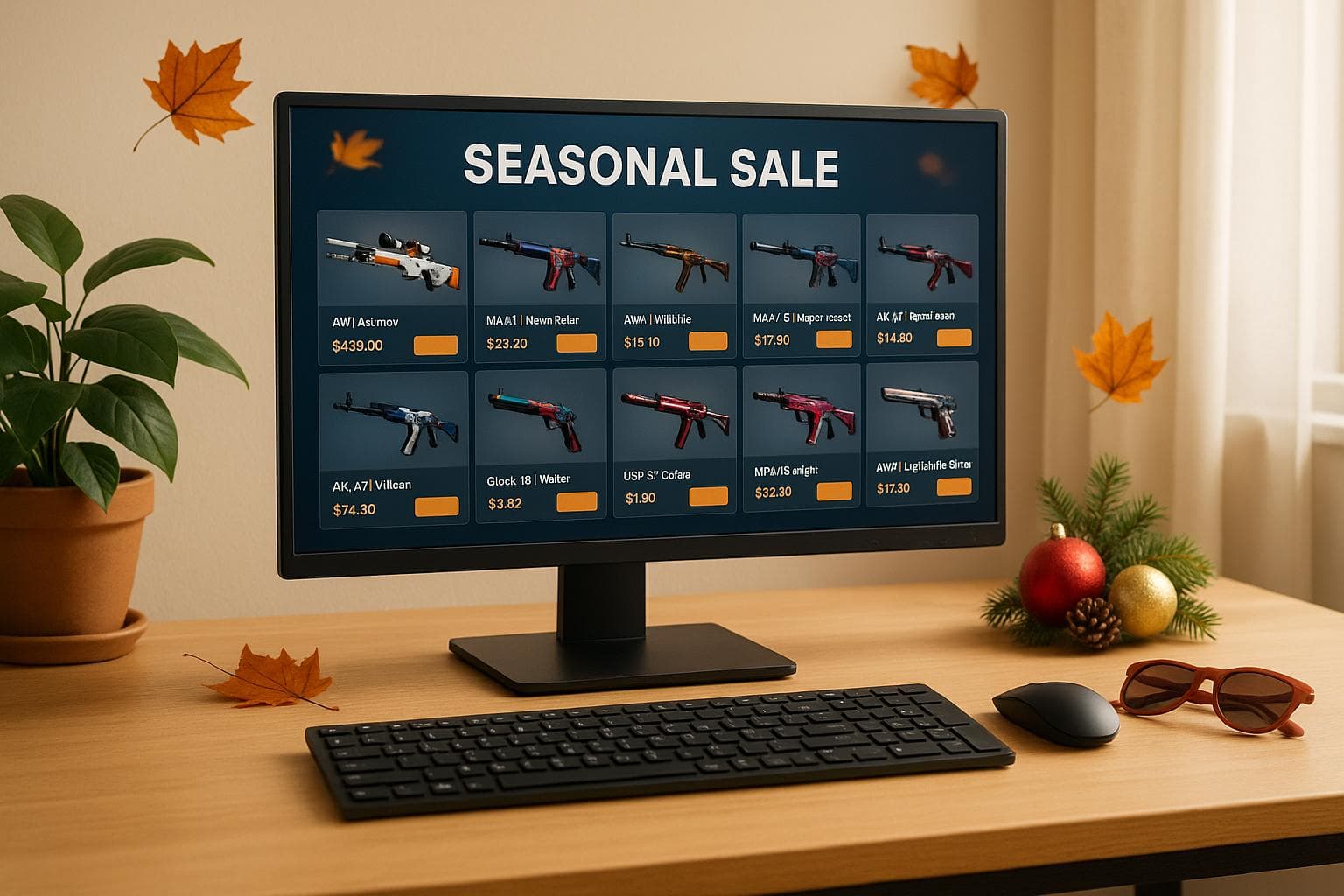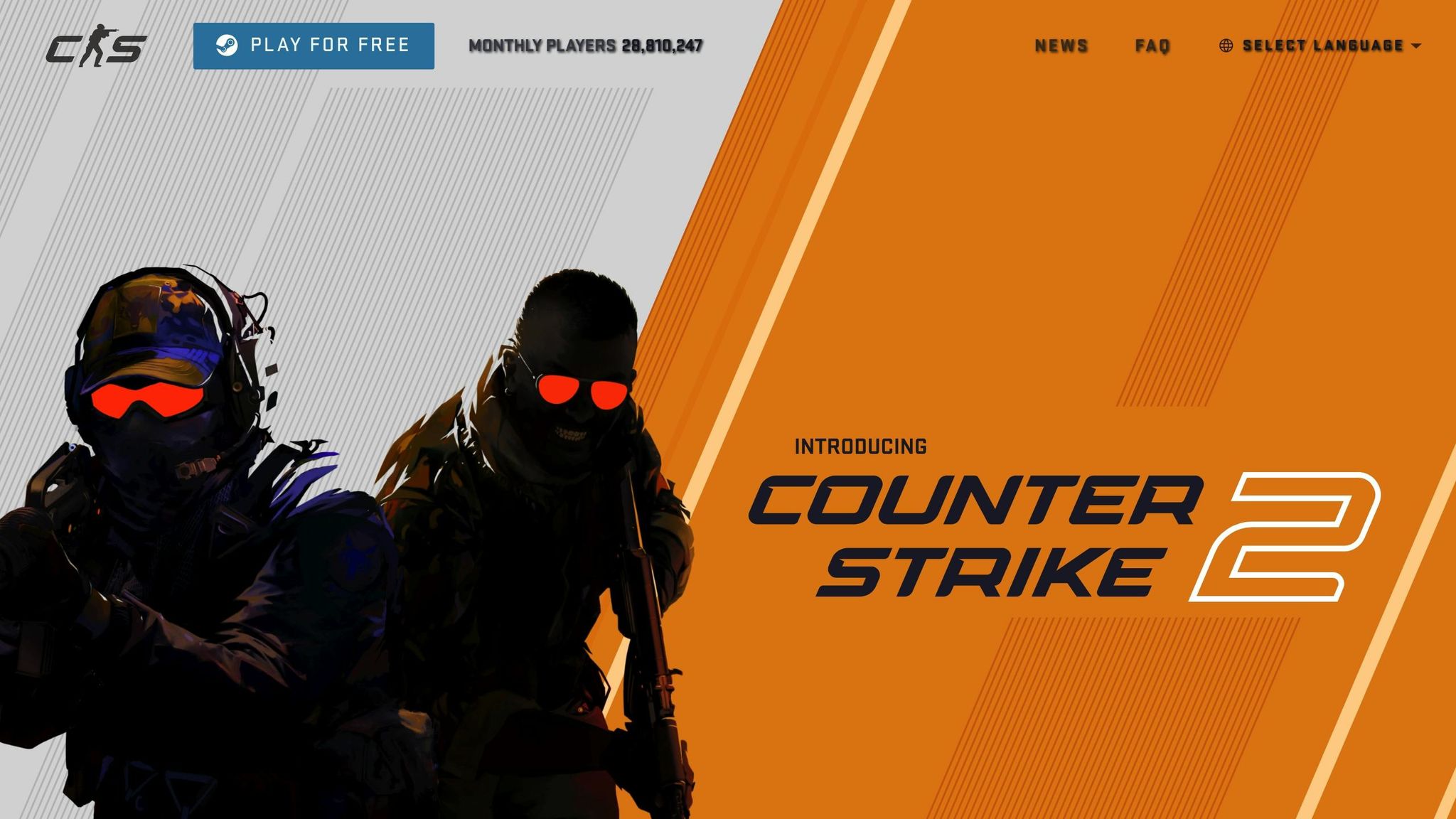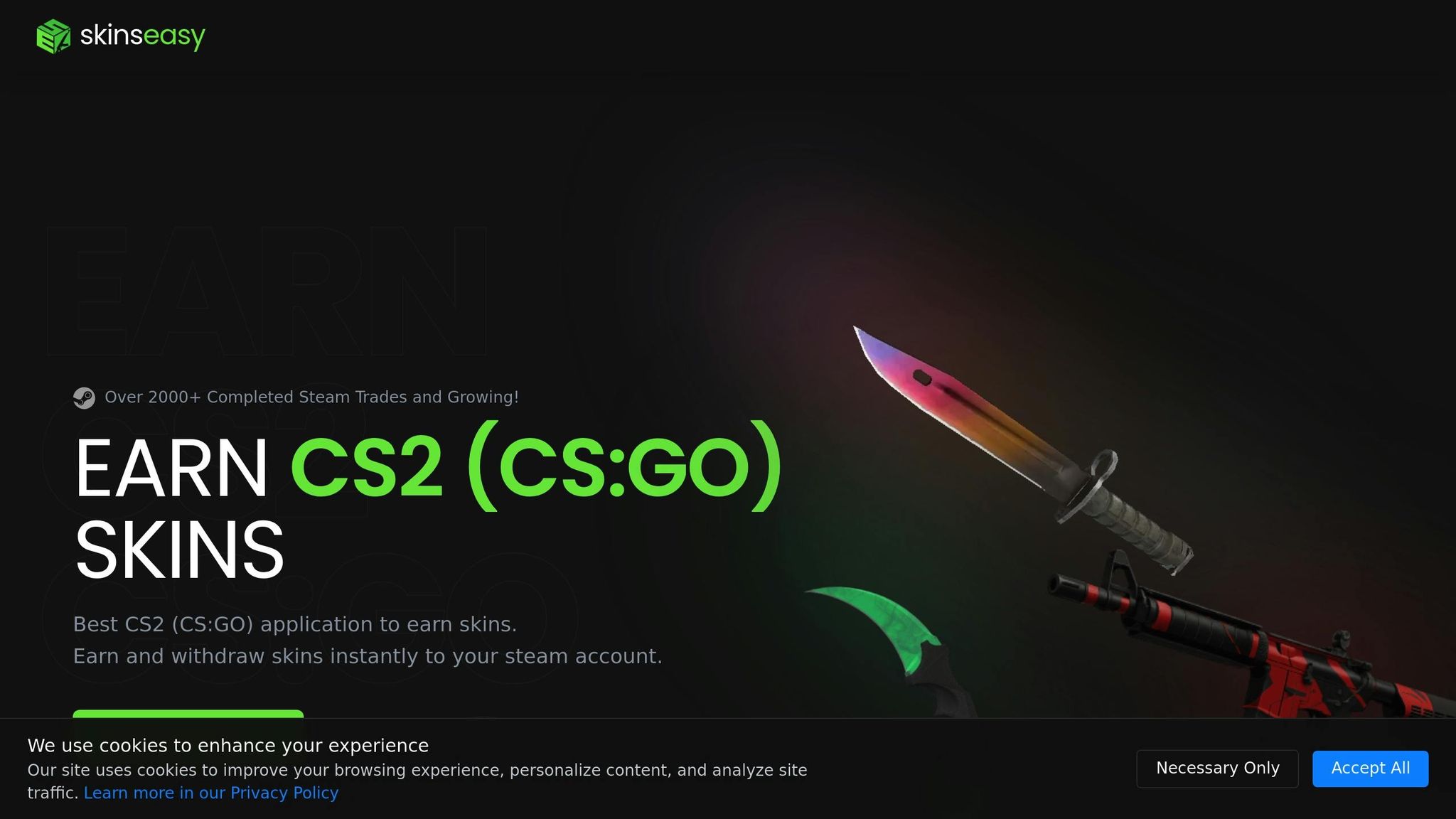How Seasonal Sales Impact CS2 Skin Prices

How Seasonal Sales Impact CS2 Skin Prices
Steam's seasonal sales create major price shifts in the CS2 skin market. During these events, players often sell skins to fund discounted game purchases, leading to oversupply and price drops for common skins. At the same time, rare skins may rise in value due to high demand from collectors.
Key factors driving these changes:
- Player Activity: Fewer players in summer reduce demand, while winter holidays increase trading.
- Market Behavior: Seasonal sales prompt mass skin sell-offs, flooding the market.
- Exclusive Releases: Limited-time skins and new collections spike interest but disrupt older skin prices.
- External Influences: Game updates, tournaments, and influencer promotions amplify volatility.
For traders, timing is crucial. Track historical price patterns, avoid early-sale rushes, and focus on mid-range skins for steadier trades. Platforms like SkinsEasy provide alternative ways to earn skins, reducing reliance on unpredictable markets.
Summer sales are fast-paced with sharp price changes, while winter sales are steadier but competitive for rare items. Understanding these trends helps you buy low, sell high, and navigate the market effectively.
CS2 SKIN PRICES are RECOVERING... (Why and What this Means)

What Causes CS2 Skin Price Changes During Seasonal Sales
Understanding the reasons behind CS2 skin price fluctuations during seasonal sales can help you make smarter trading decisions. These changes aren't random - they're influenced by predictable factors that shape supply and demand within the CS2 marketplace.
Supply and Demand Changes
The biggest factor behind price shifts during seasonal sales is the rapid change in supply and demand. When Steam announces major sale events, the marketplace reacts with noticeable price movements.
Seasonal sales often include discounted cases, which flood the market with new skins. This sudden increase in supply generally pushes prices down across many skin categories. At the same time, holidays and sales periods bring more players into the game, as people have extra free time to play CS2. This surge in activity can drive up demand for popular or trending skins, creating a tug-of-war between rising supply and heightened demand.
Major tournaments also play a role. These events increase trading activity and fuel demand for team-related skins and stickers. Once the tournaments end, players tend to sell items they’ve earned from drops and cases, further boosting supply and potentially driving prices down.
But that's not all - limited-time cases and new skin collections also shake up the market in big ways.
Limited-Time Cases and New Skin Collections
Seasonal sales often bring exclusive cases and new skin collections, which can cause some of the most dramatic price changes. Limited-time cases create a sense of urgency and scarcity, driving up prices for the most sought-after items.
When Valve introduces new skin collections tied to events, the initial supply is typically low while demand skyrockets. Players eager to own these exclusive items are willing to pay a premium, leading to sharp price increases. The limited availability and high demand combine to push prices well above normal levels.
These new releases also impact the prices of older skins. As attention shifts to the latest collections, older skins in similar categories may see price drops. This can present opportunities for buyers looking to snag deals on established collections.
Skins tied to in-game events, operations, or major tournaments tend to generate even stronger demand. Their exclusivity and prestige make them highly desirable for players and collectors alike, and their prices often stay high long after their initial launch.
External factors add yet another layer of complexity to these trends.
Outside Factors That Affect Skin Prices
In addition to sales and new releases, several external influences can affect CS2 skin prices during seasonal periods. Game updates and balance changes can suddenly make certain weapon skins more or less popular, leading to unexpected price shifts.
Social media and influencer endorsements can also have a big impact. A single post or stream showcasing a particular skin can quickly drive up demand and prices during sales events.
Promotional events and partnerships with Valve can add to the volatility. Special tournaments, collaborations, or anniversaries might introduce unique items or bring attention to existing skins, causing sudden demand spikes. These factors often amplify the price swings already happening during seasonal sales.
Timing is everything. When these external factors align with seasonal sales, the combined effect can lead to some of the most dramatic price changes in the CS2 skin market. By staying aware of these drivers, traders can better anticipate market shifts and make more informed decisions.
Common Problems Players Face During Seasonal Sales
Seasonal sales bring a unique set of challenges for CS2 players and traders. With trading volumes skyrocketing, market fluctuations become more unpredictable, leaving even seasoned traders scrambling to keep up. Here's a closer look at the hurdles players face and how to navigate them.
Higher Prices for Rare Skins
One surprising trend during seasonal sales is the spike in prices for rare skins. With more players active, the demand for coveted, high-tier items surges, driving prices higher. For those saving up to snag these rare finds, this increased competition can make purchases feel out of reach.
To sidestep overpaying, consider alternative ways to acquire skins. Platforms like SkinsEasy let users earn CS2 skins by completing tasks, surveys, or playing games. These platforms often offer deals that can stretch your budget further - sometimes up to 50% better value compared to direct purchases.
Oversupply Leading to Price Drops
While rare skins see a price hike, the market for other skin categories often faces the opposite problem. Seasonal sales prompt many players to offload their current skins to fund discounted game purchases, flooding the market with inventory. This oversupply typically causes prices to drop, sometimes by 5% to 10%. On top of that, reduced player activity during these events further weakens demand, pushing prices even lower.
Managing Rapid Price Changes
Another headache players face during seasonal sales is the lightning-fast pace of price shifts. Market trends can change in the blink of an eye, making it nearly impossible to time trades perfectly. By the time a good deal catches your eye, the market may have already moved, turning trading into a high-stakes game of speed and constant vigilance. This relentless cycle can make the process more stressful than rewarding.
sbb-itb-885d88f
How to Handle Seasonal Sales and Get Better Value
Navigating seasonal sales requires a different game plan than your usual trading strategies. The secret lies in preparation, smart timing, and leveraging tools that help you ride the waves of market fluctuations. Let's dive into some practical strategies to help you track trends, time your trades, and explore alternative earning methods.
Tracking Price Patterns and Historical Data
Start by digging into past trends. Keeping tabs on historical price data can give you a baseline for typical fluctuations leading up to major sales events. Begin monitoring daily price movements and market factors for your target CS2 skins well before the next big sale.
Seasonal sales - like summer and winter promotions - often follow predictable patterns. By analyzing these trends over time, you can spot opportunities early. Also, pay attention to pre-sale price drops. It's common for skin values to dip as traders adjust their inventories ahead of a sale, creating a window for savvy buyers to snag great deals.
Timing Your Trades for Maximum Impact
Timing is everything when it comes to seasonal sales. Use your trend analysis to plan your trades around the market’s emotional cycles. A good rule of thumb? Avoid diving in during the frenzy of the early sale stages. Instead, wait for the initial rush to settle - this is often when prices stabilize, and better deals emerge.
Skins with mid-range values tend to show more consistent trading patterns, making them a safer bet compared to items at the extreme ends of the price spectrum. Focus on these for more predictable outcomes.
Leveraging SkinsEasy for Smarter Gains

SkinsEasy can be a game-changer during seasonal sales. It offers a unique way to grow your CS2 skin collection without relying solely on the unpredictable market. By completing tasks and surveys, you can earn skins that are sent directly to your Steam account. This method reduces your dependence on market volatility and adds a steady stream of new items to your inventory.
Even better, SkinsEasy’s community features - like its active Discord channel - let you tap into real-time market insights shared by other users. This collaborative environment can help you make smarter decisions about when to trade or supplement your earned skins with additional purchases.
Summer vs Winter Sales: How They Differ
While hard data might be sparse, traders have noticed clear seasonal trends in the market. In the U.S., summer sales typically coincide with school vacations and travel season, sparking increased market activity. On the other hand, winter sales align with the holiday season, when many focus on gift-giving and adding to their collections.
These seasonal contexts influence trading volumes and price volatility, creating distinct patterns that set summer and winter sales apart.
Side-by-Side Comparison
Here’s a closer look at how summer and winter sales differ:
| Factor | Summer Sales | Winter Sales |
|---|---|---|
| Market Activity | Tends to be more dynamic | Generally steadier during the holidays |
| Price Movements | Often shows faster fluctuations | Changes occur at a slower, steadier pace |
| Trading Approach | Quick decisions can be crucial | A more patient strategy often pays off |
| Strategy Focus | Seizing opportunities in active trading periods | Combining strategic purchases with earned skins |
Understanding these patterns can help you refine your approach to trading. Whether you're navigating the fast-paced summer activity or the steadier winter market, tools like SkinsEasy can assist in adapting your strategy to these seasonal shifts.
Main Points for CS2 Players and Traders
Seasonal sales bring predictable patterns that savvy players and traders can use to their advantage. Both summer and winter sales present unique opportunities and challenges, each demanding a tailored approach.
Timing is everything. Summer sales tend to fluctuate quickly, while winter sales are more stable. Understanding these patterns allows players to seize buying opportunities and maximize profits. By combining market timing with other strategies, you can better navigate these seasonal shifts.
Instead of relying solely on market timing, diversify your strategies. While tracking price histories and seasonal trends is essential for traditional trading, you can also earn skins through platforms like SkinsEasy. This approach minimizes the risks tied to market volatility. Winter sales, with their steadier pace, are particularly well-suited for accumulating skins through a mix of methods.
Diversification is key during unpredictable market periods. Pairing earned skins from platforms like SkinsEasy with well-timed purchases creates a balanced strategy, offering more stability across different market conditions.
Seasonal sales also impact skin categories differently. Rare and high-value skins often see price increases during major sales due to higher demand, while common skins may lose value as the market becomes oversaturated. Recognizing these patterns helps you focus on the right skin categories when demand shifts, giving you a competitive edge.
Ultimately, consistent effort beats perfect timing. Whether it's navigating the rapid changes of summer sales or the steadier winter market, having multiple ways to build your collection - through market purchases and earning platforms - offers flexibility that pure market timing simply can't provide.
FAQs
When is the best time to buy or sell CS2 skins during seasonal sales?
Seasonal sales, like summer and winter promotions, can have a big impact on CS2 skin prices. During these events, prices often drop because of increased supply, making it a great time to snag some deals. After the sales, as demand picks up, prices tend to climb, offering a chance to sell for a profit.
To stay ahead, keep an eye on market trends and price history. Look for price dips leading up to major seasonal sales and consider selling when demand peaks - like after the sales end or during the excitement of tournaments. Timing your trades carefully can make a huge difference in maximizing your returns on CS2 skins.
For a secure way to trade or collect skins, SkinsEasy is worth checking out. It allows you to earn, trade, and collect CS2 skins for free by completing tasks, playing games, or participating in surveys. Plus, skins are delivered straight to your Steam account quickly and securely.
How can I handle CS2 skin price changes during Steam's seasonal sales?
Managing CS2 skin prices during Steam's seasonal sales calls for careful planning. A smart move is to purchase skins before the sale kicks off, as prices often climb during the event due to higher demand. On the flip side, if you're looking to sell, doing so during or shortly after the sale could help you take advantage of price spikes.
To navigate these fluctuations effectively, consider diversifying your skin collection to spread out risks. Keep a close eye on market trends, and use price alerts to act quickly when opportunities arise. This way, you can make informed decisions and stay ahead in this fast-changing market.
How do game updates and influencer promotions affect CS2 skin prices during seasonal sales?
Game updates and influencer promotions play a major role in shaping CS2 skin prices, especially around seasonal sales. When updates roll out new skins or enhance existing ones, they often create a surge in demand, pushing prices higher. Likewise, when well-known influencers spotlight specific skins or collections, it can spark a wave of interest, leading to sudden price jumps.
Seasonal sales tend to magnify these effects, causing prices to fluctuate even more. Some skins may see sharp increases in value due to the extra attention and demand. To stay ahead, keep an eye on market trends and be ready to act quickly when prices match your buying or selling goals.